Knifewalls
It’s only a knife, one with no attractive qualities beyond its inexpensive price and availability. It’s one of the cheapest to be found on any market and as far as functionality goes you cannot beat it no matter what you pay for such a working knife. But would an ebony or a rosewood handle offer any more than possibly better looks? My `Stanley folding pocket knife exceeds all of the others I have ever used bar none so without exception. There are one or two other similar but not quite the same knife types around. No other knife comes close to the Stanley 0 10 598. I pick mine up about every other minute and have done so for over a decade now. That’s a lot of knife use and the material I cut with it is not particularly forgiving; wood has all manner of eccentricities ranging from wild grains to a million different knot densities and hardnesses.
I don’t usually go for a product that is more utilitarian and mass-made, but this one suits woodworking of the type I do in making furniture and general benchwork. I like everything about the knife’s functionality: the long point; its slender profile; the thinness of the blade that allows a tight closeness to a dovetail side or straightedge. The blade is amply strong enough for all woods, and, most importantly for me, it can be resharpened many a dozen times which is always quicker than changing the blade.
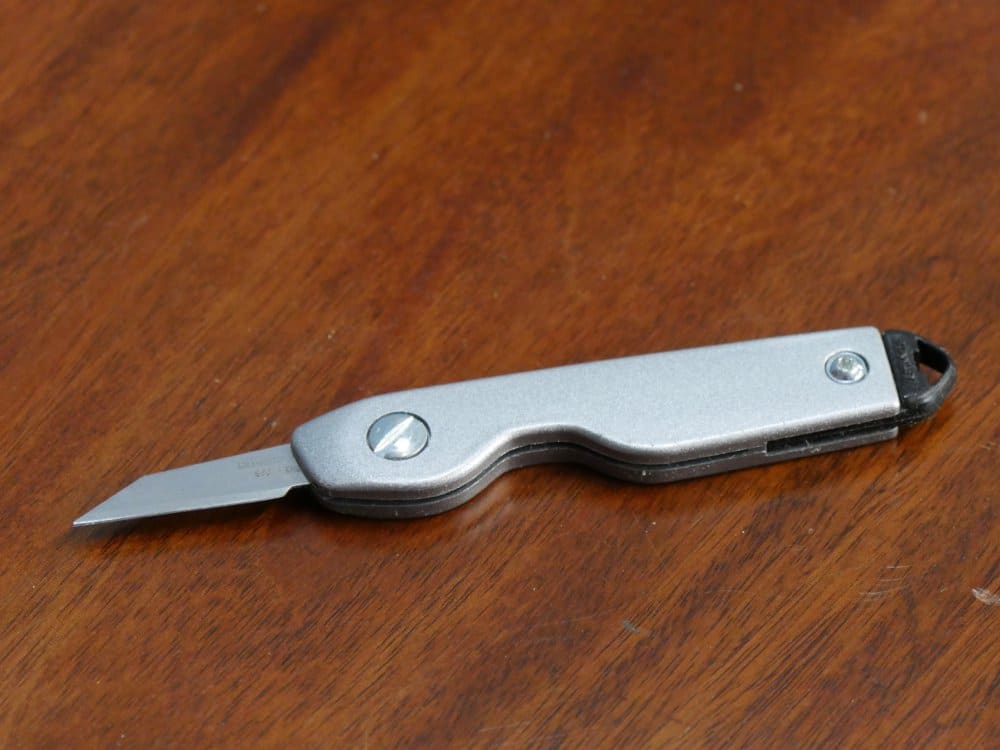
Why am I promoting such a knife when I rarely name products? Well, mostly it’s because there is no equal match I suppose. Also, I can rely on it, which I do, and it has proven to be a very reliable tool. I have many nice knives, a collection of homemades and others through the decades; I have two commercial versions in my right-hand jeans pocket right now and I have carried a knife there for 60 years and never go anywhere without one. I have also enjoyed making knives for my work through the decades. When I first saw this Stanley version come on the market it was an answer to my shop classes. Students immediately loved them.
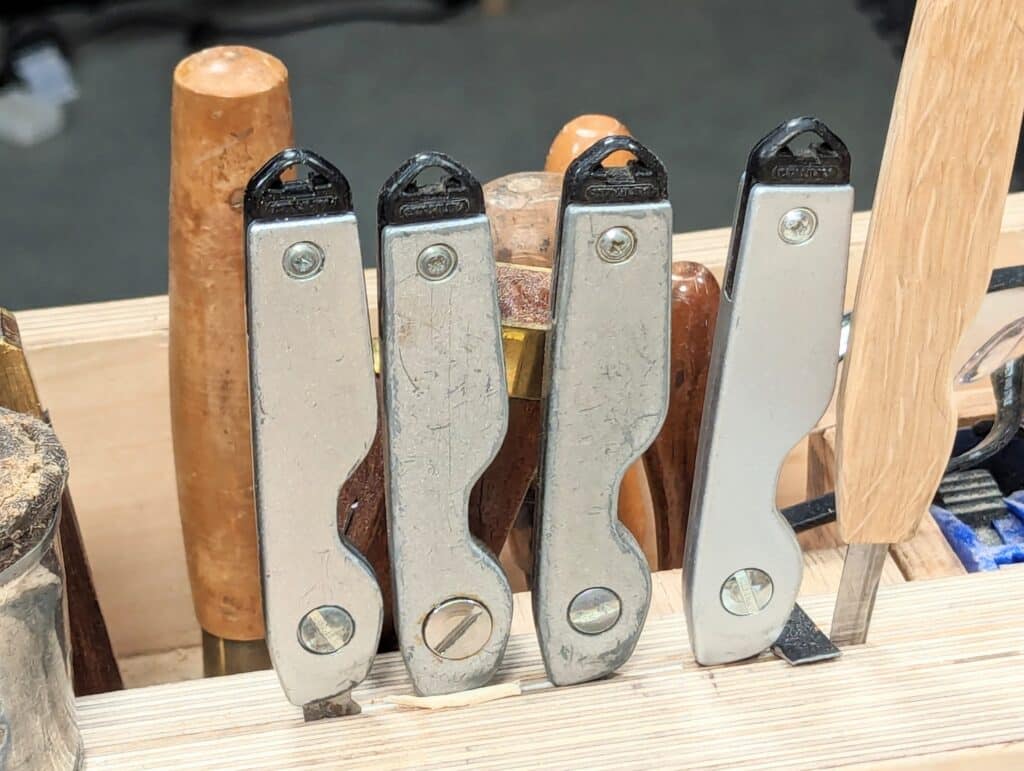
If I misplace one of the five Stanley pocket knives always arrayed in a row on my workbench but now somewhere loose on my benchtop then I go for the immediacy of one in my other types in my pocket. The Stanley version has a lock blade when opened and in use and the folding aspect of the knife works well for pocketing if I want or need to. Even though all of the internal mechanisms are polypropylene, I have never had any part break or fail.

Where the knife truly excels is in initiating and deepening my knifewalls surrounding dovetails and the shoulder lines of tenons for M&T joints or the sides of housing dadoes. The slender blades and the long point get me right and tight into the corners and with a light pass, the knifewall is so very fine––critical for perfect cut lines and tight-fitting joints. But there on those shoulder lines the knife slices perfectly. Press the knife steadily and carefully to follow the blade of the square and your shoulder lines will always come out spot-on, dead square every time. My first knife now has no powder-coating left and is smooth as silk, which I like. It’s my favourite.
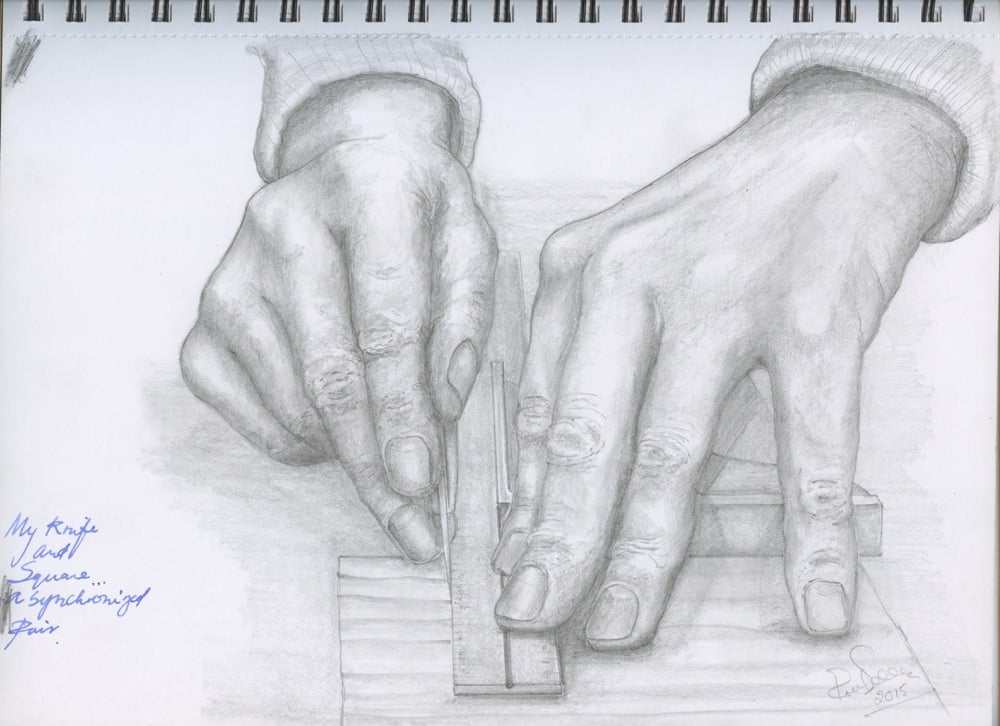
Why this, Paul? Some tools are just well worth sharing. It’s funny that the least expensive most utilitarian tool I use minute by minute deserves the accolade of best used tool. Just under £7 plus VAT brings it home on Prime for £8.35. You can buy three blades for £1.75 so with the two with the knife that’s a couple of year’s work. You can buy 50 blades for £23. and that’s a lifetime of woodworking no problem.
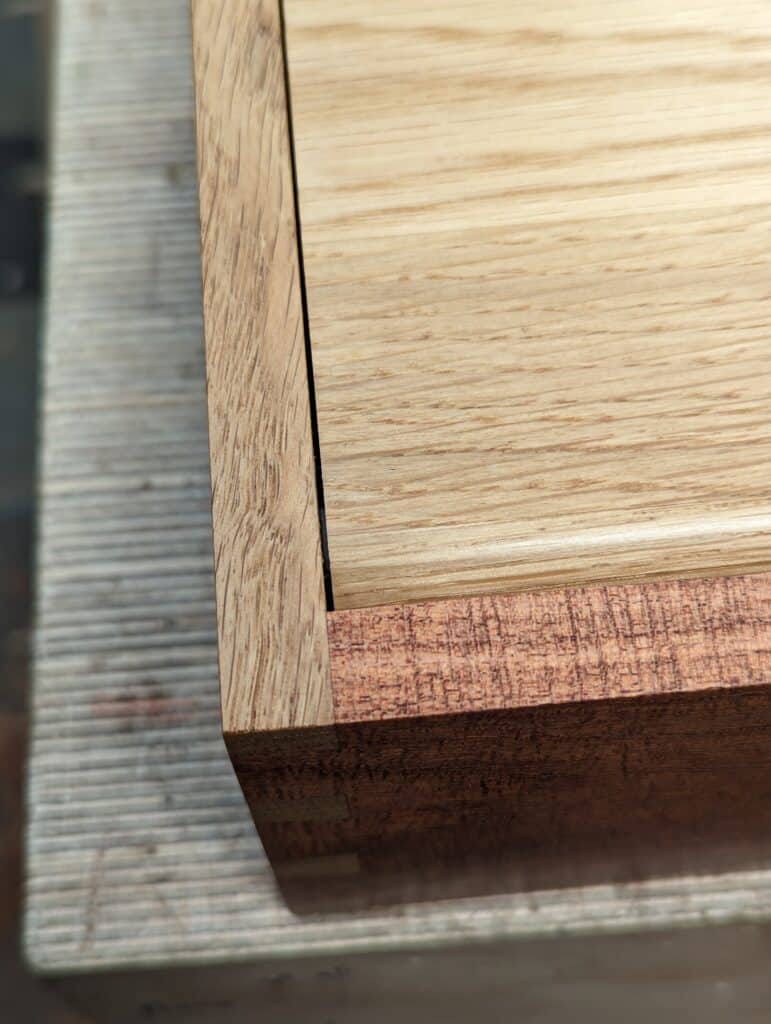
Why knifewall? I coined this term because it so accurately describes what the knife actually does in practice. In teaching my hands-on classes to thousands through the decades, I found myself subconsciously using this term simply because it best described what I was establishing in pulling the knife across for the cross-grain cuts on shoulderlines. As the chisel and saw cuts held to a definitive line, it establishes the tightest cutting line and acts as a wall for subsequent cuts with knives, chisels and even shoulder planes, bullnoses and such. In actuality, it eliminates the need for any shoulder planes hence my never being seen to use one in my videos. I certainly do not deny the added benefit of owning a shoulder plane but as the knifewall always guarantees dead-on squareness, it is more a luxury plane and is rendered redundant for truing up shoulders to tenons which is very limited if using the knifewall.
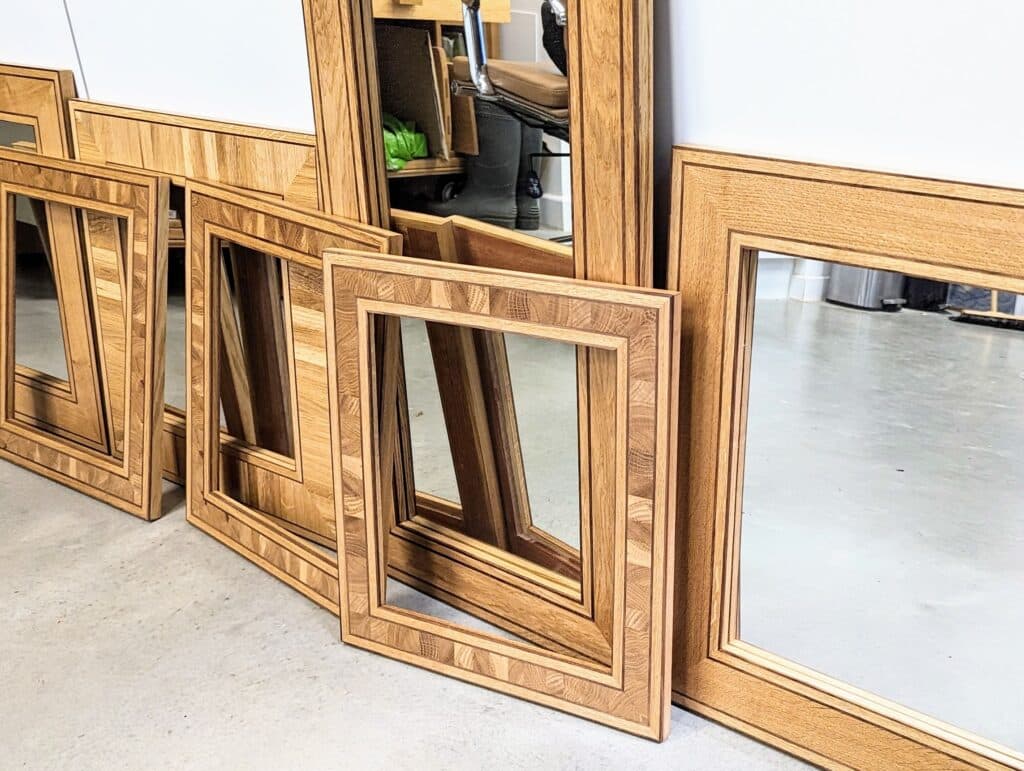
My mitres on a picture frame in a recent video series (where I actually made fifteen picture and mirror frames) came from the knifewalls for each of the forty-five corners. All that was left was to get the lengths bang on and the mitred corners always came out perfectly. Ninety-nine per cent of bench work is ninety-degree cutting to the long axis of the grain in the wood. If you are uncompromising in establishing the knifewalls and working to them then it pretty much guaranteed square frames, square boxes, drawers, doors, panels and so on. It becomes almost impossible to make any of these out of square and that results in the overall project being square in the end result too.
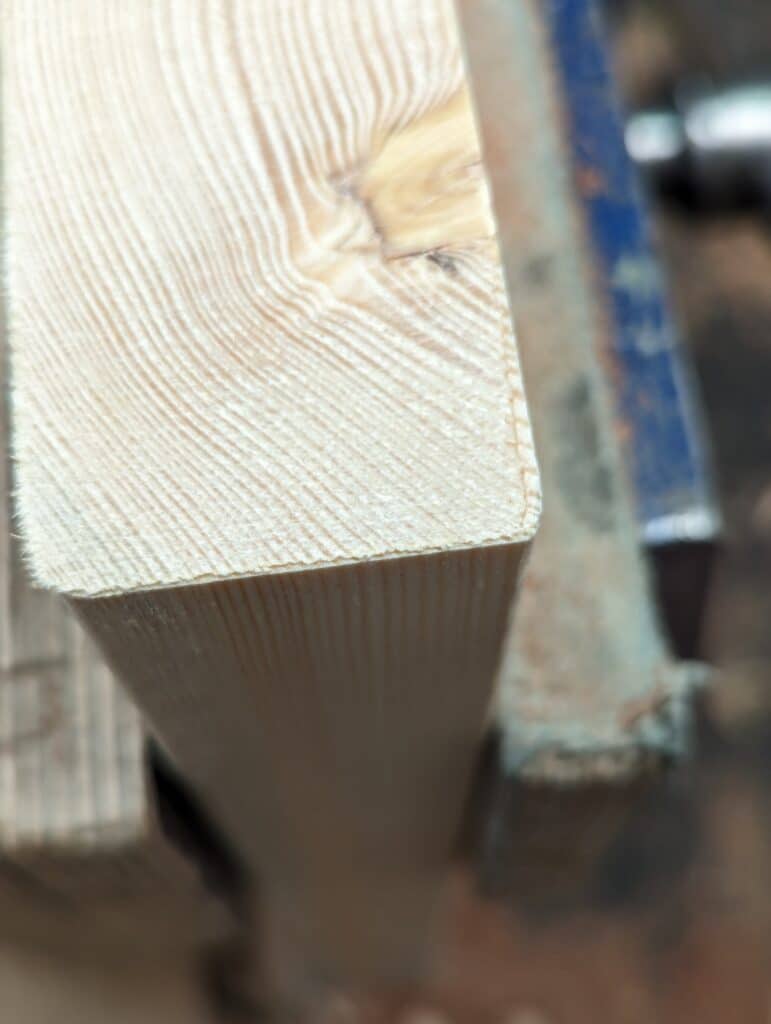
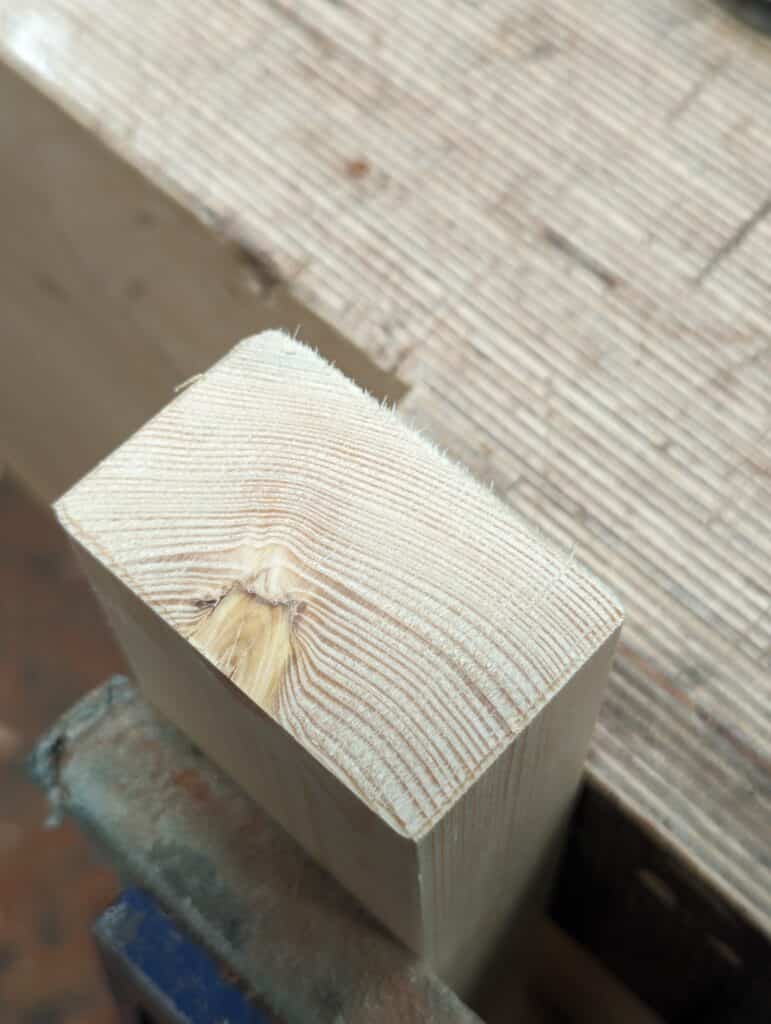
It’s funny that an Aussie site quotes me as saying I invented the knife wall even though I have been clear that the physical making of a knife wall with a knife in wood across the grain for making joints and cut lines predate historical writing as such. What I actually lay claim to is a more precise naming or perhaps renaming of the practice and dismissing more erroneous terms commonly used as suitable in my area of precision woodworking. Marking knife, and striking knife fall far short for my working with the knife and then too for my audience and the ones I teach and train in furniture making rather than carpentry. With my use of the knife, I create a physical wall, a barrier if you will up to and against which other tools are led in the cut and severing of fibres across the grain. I do wish that they would get it right but when someone is offended they usually are blinded by their own pride and intent. A marking knife simply scores the surface and that with a dull implement and especially was this so before graphite pencils came into common use. A striking knife similarly marks the surface as in striking marks on the wood with a point.

As these were more rarely sharpened the outcome on every marking knife I ever came across was too dull to cut even butter. As it is in most cases, stand out from the crowd and terms and practices you never claimed as yours become their source of misinformation and offence and another source of malcontent for other misinformed commenters to use as a platform. As stated, the term knifewall was not used anywhere in the history of woodworking until I started using it for clarity in my classes hands-on. All I did was claim the term and not the practice. Others now use it when they never did until they heard it from my using it and passing it on to millions to date. What is also common is to never contact me personally and ask me the right questions. It’s more common nowadays to misquote and create issues that actually never existed. A sad reality of current platforms universally. On this particular forum they also drop in the usual terms like cult-following and narcissism for good measure.


Thanks Paul. I agree with you that this knife is very good. I, however, fell in love with the red handled one that you used maybe 5 to 10 years ago on the master class series. I think it is slightly bigger in the handle and fits my hand just a wee bit better. And it is also comparably priced to the Stanley one. of course, I had to try a few knives when I was starting out just to see what the others are like. I spent up to 10 times as much on a premium marking knife for woodworking; the Stanley and the red handled one is vastly superior. If I ever feel ambitious, I might take one of the replacement blades and carve my own handle to basically match the red knife one, but I certainly don’t need to do that.
My dad gave me my first pocket knife when I was seven years old and he expected me to carry it daily. When I didn’t, he politely gave me some grief for not having it and said that knives are handy to have on you and can be used for variety of tasks. It was a Boy Scout pocket knife that had the can opener, screwdriver and awl. Somewhere in my 30s, I realized that this knife had started to become precious to me because it was the first pocket knife. My dad had given me, and as such, I retired it for fear of losing it. Now, I carry a midsize Swiss Army knife that is very similar to what my dad gave me as a normal blade. 82 screwdriver blades and a bottle and can opener. I have spent much more money, trying various other knives, but the simple Swiss Army knife really suits my needs. I can’t find anything better than it either And I have certainly tried
This little blade will serve one well… but not me. I looked on Amazon, found it for $10. But the closeup photos showed that the nail nick (where you grab the blade with your thumbnail to open it) cannot allow the knife to be opened with one hand.
All my adult life, I have carried various pocket knives from Schrade’s Uncle Henry, Buck’s Folding Hunter, and lately Spyderco’s un-serrated offering. None of these is suitable for precision woodworking, but all can be deployed one-handed, and returned to the pocket or clip one handed. Maybe Kershaw has a small one that’ll work. If they do, it won’t be $10; more like $100.
kerhaw has many 10$ offering appropriate for this need
Happy New Year, Paul! This knife and the knife wall technique is the most valued bit of knowledge I have gotten from your YouTube channel. Thanks for sharing all your skills with the world!
That’s item numbers:
(293JW) blades
(391JW) knife
Matt
This cult follower is sure happy that I signed on years ago and look forward to many more.
Paul, I adopted your Stanley knife as I began my woodworking journey. I am pleased with it and have two knives and a dozen blades at the ready. Thank you for sharing your experiences and insight with a newbie.
how do I buy one paul ASAP pleasethank you scott
I’ve bought these knives on eBay on three different occasions.
morning mate its scott thank you for replying and showing all ur skills amazing I’m already a member
If you are in the US, Ace Hardware and others like it have them stocked in their stores.
Yup, I got mine from Ace (on Paul’s advice) a couple of years ago. It is definitely superior to the more expensive marking knife I have. I’ve only replaced the blade once, and for some dumb reason it didn’t occur to me that a replaceable blade could also be resharpened. Is there a video where Paul demonstrates his sharpening method for this type of blade? I’d watch it.
Yes, I do remember a video about sharpening it. Not sure of the name of it now.
Or maybe it was a blog?
what about amazon ??
Scott,
Amazon carries them and they are available in the States so I am assuming Europe as well. Less than $15 plus whatever tax is applied in your area. It is morning on a week day as I write this and Amazon promises they can deliver it today. Mine is on the way.
I thought I recalled Paul saying in one video these were not available in the States so I never looked but once he gave the model number, the search was easy. Here is the link:
https://www.amazon.com/dp/B0001IWDBU/?coliid=I981697OTBXE3&colid=B5B507OLL6DN&psc=1&ref_=list_c_wl_lv_ov_lig_dp_it
They also carry a pack of 50 replacement blades for under $16.
Hope this helps.
Buy Stanley stock.. Paul just started another market run
Yeah! I should have added I GET NOTHING FROM STANLEY NOR ANY SALES OUTLET NOR WOULD I EVER TAKE IT. Just incase some thinks its product placement, freebies or a sponsoring of some kind. Never have never will. I like a clean site. Also, I disallow some comments promoting other products just to keep things clean and clear. This one gets the occasional mention because of its out and out value to woodworkers to help them.
Ha! This could be bigger than the Aldi chisel bump!
I’m keen to hear when Aldi have them in stick.
My friendly neighbourhood fox stole my chisel roll and destroyed it, losing one of chisels along the way!
I’m afraid Aldi no longer offers those chisels. They’ve not stocked them for about three years now.
Just checked Amazon. Out of stock for the UK Stanley. Inspired by the Maestro, I purchased one in September ’22, as reminded by Amazon. Love mine. I would caution against the plastic US version as seen in local US hardware stores. No way they’re as solid.
All the ALDI chisels I saw were chinese.
Paul,
Thank you for clarifying the use of the term. I have taken up woodworking as a hobby, now that my retirement is in site. Watching your videos, I simply assumed the term was an old part of fine woodworking, even though I never heard others using it.
I enjoy watching your content and have learned so much. Your manner of teaching shows long familiarity and understanding what cannot be communicated by video. Where you apply pressure on a plane and why and so forth. My work shop is much more hand-tool centric than it was because you have taken away some of the mystery from working by hand. Please continue to do what you do for as long as it gives you pleasure. Despite some getting their noses out of joint, there are those of us who truly value and appreciate your unique ability to explain what you are doing without assuming we know what we do not.
Best wishes for the new year and I look forward to more videos.
Paul could you please give us the dimensions of the jig you made for sharpening the knife at the correct angle
hiya Paul its scott I’m in hull and doing my college work at 37 lol latest better then never just finally grown up a little doing college joinery but I love the hand tools I’m desperate for work space mate what would you do Paul we’re can u make space comfortably
Is there any special guidance you can provide for sharpening the blades?
The thing most people miss , is that pedagogically, the term KNIFE WALL is clarifying and descriptive.
Good teachers do that. When I first realized that it was NOT replacing a puny pencil line with a puny knife line but creating a physical barrier for other tools like a chisel or saw, the light bulb went on.
You introduced a PROCESS that adds precision to hand work. The terms ‘Marking knife’ or striking knife , both imply ‘Knife as a substitute for a pencil. You are always careful to say create a Knife Wall, and always demonstrate multiple strokes with the knife and following up with the chisel to reveal a true “Knife Wall”. No one else did that until you introduced a better, more descriptive term for the PROCESS.
I always have one in my pocket, and they are easily and quickly sharpened.
As always, Thanks
It’s kind of amazing to see how many true craftsmen use the term “Knife 🗡 wall”. It didn’t take long for such a name to be accepted by so many. p
Yes, a month or two ago, I vaguely remember seeing the term Knife-wall in a book. Couldn’t remember which, but a trip back to the library and some book shuffling and page turning verified it was in “Hand Tool Basics” by Steve Branam (2018). Finding Steve’s blog home page, one entry was: “Building a Paul Sellers workbench” and after 30 sec of clicking around, a 2012 blog entry titled “Paul Sellers at the woodworking show” (Springfield, Mass.) So yes like the branches or roots on a tree, Paul’s influence is spreading 🙂 I agree the term is important, because when I read older books I now see that the technique is (mostly) there, but I never “got-it” (nor would have). Knife-wall. Just enough to stop you and go “wait, what’s that?” and then “ahh I get it”.
For me it happened around my first real class back in 1990 teaching ten students in Kerrville Texas at Schreiner University for the Texas Arts and Crafts organisation. I needed clarity and when I said knifewall in my classes after that the thousands of students went, “Hold on a minute, what’s a knifewall?” So in my pre internet days, pre 2009 really, for me, this term had never been used but here it is now commonly used throught the world. When it makes it into the Oxford dictionary I will know we are there.
Since learning of this knife from Paul’s website many years ago I haven’t used anything else. Actually, now I think of it, I was given a lovely looking wooden handled marking knife, but after using it a couple of times I went straight back to my Stanley folding knife. There is no better – thank you Paul.
Dear Paul,
Thank you for writing this article on the Stanley 0-10-0598. Thank you also for writing earlier on the Swann Morton SM00 (and its retractable cousin, the SM0-R), https://paulsellers.com/2015/11/another-knife-i-like/ I have not yet held the Stanley 0-10-0598, though some day might give it a try should my Swann Morton SM00 ever fail.
All the best to you and all that you and your entire crew does to make this world a better place in the coming year! An early happy birthday to you too!!
Hi Paul,
The Stanley knife you use is truly wonderful. I would not be without the two I own. Thanks for recommending them.
Years ago I got two of these, after a close look at Paul’s videos. They are a great all rounder, great for putting a long point on pencils too! On Amazon you can buy blades half price and they fit with a little coaxing….
Swan Morton SM01 blades will fit these knives. £13 for fifty, Stanley blades being £23 for fifty.
Happy new year all!
I agree with the comments about how good this little knife is, been using it for about 5 years. When you say, “coaxing” the blades, do you mean the Swann Morton blades? I’ve not tried them but don’t want to waste good money if they are really awkward to fit properly.
No, they fit perfectly. I have used both interchangeably for many years no problem, Phil! Hazarding a guess, I would say they are made in the same factory by the same maker.
Several years ago I followed your advice on these Stanley knives: I bought #1 being the UK version and #2 being the US version. They are a little different but each works beautifully in creating a knife wall, especially in deepening the registration line (I use use a round cutter style, sorry to disagree with you about using a pin driven thru a wood beam, the former works better for my 85 yr old hands and eyes) for the base of dovetails so a sharp chisel drops neatly into it. Appreciate your help on this!
Thanks, Paul Now, if I had bought a Stanley knife years ago I would have saved enough to afford an Auriou rasp! Just to name another product Paul likes.
But the truth is that my main need is to improve my hand skills with the tools I do have. Thanks, Paul for your help with that underlying project.
I carry a three-bladed “stockman” style knife, and I use the sheep’s foot blade for marking. It’s always in my pocket. I also use the same knife to quickly clean up nasty edges where there is some splintering.
Hi Paul,
I truly appreciate your help with the explanation you give me to help me with my learning to improve my skills. I’m still trying to do a little better each day. I purchased two of the knives after seeing you use it a couple of years ago and they work great. Thanks again for all your help. Happy New Year to you and your family!
Thanks again Paul for all your support.
Something not to be overlooked, and something I may have missed if Paul discussed it before, is how helpful that narrow band left by the knife wall after making a saw cut can be. I first realized it when cutting a glued-up tabletop to length. I had established the knife wall all around the end to be sawn, and then cut safely on the waste side with the intention of planning to the finished edge. As I got close to the knife wall, the waste side began to flake away clearly indicating my progress, and assuring me a perfectly straight and square end as I planned down to that narrow band left by the knife.
I’ve had that happen. When I realized and understood what was going on, pure bliss of self-discovery.
Hi Paul, I’ve been using these knives almost daily since finding out about them via your blog several years ago. It’s the only marking knife I use as I sold my ‘traditional’ marking knife in favour of the practicality and accuracy of the little Stanley knife. I carry one of these in my pocket whenever I’m in the workshop and feel something is missing if I can’t find it, so now have two, just in case. This is also the first woodworking tool that I gave my son.
Thanks for sharing your wisdom and introducing me to this wonderful tool.
The Stanley 010 598 cost $ 13+ change USD on Tuesday from Amazon in USA. Now on Saturday it is $17 +. I ordered mine. It will be fun to see how high they go.
Yes, that’s Amazon USA for you! The cost has hardly changed in the last five years here in the UK.
Currently unavailable on Amazon.
Just looked up the Stanley 10-049 and it’s available on Amazon for $9.99. I believe this is the US equivalent to Paul’s knife. I’ve bought and used or gifted about 5 over the years now. Great knife.
These don’t appear to be available in Canada on Amazon or on the Stanley site, only through ebay where a used one is about $35.00 with shipping. The thrift stores has plenty of paring knives for cheap so I used the poor-man’s tutorial and make a couple for $1 total. Work very well, just don’t fold, but I have other pocket knives for that.
Others there in the USA are saying it is available from Amazon USA for somewhere between $13 and $17.
Thanks for that note, with exchange and shipping on Amazon it works out to about $33 Canadian.
Amazon USA has it for $14.68 USD right now .
The Canadian Amazon site has the knives and blades occasionally. You just have to get lucky.
I bought a few many years ago here in Australia and never looked back. My much more expensive knife just sits in it’s box. I kind of regret wasting the money on it but I was helping out a local tool maker with the purchase I guess. Sorry Chris V. if you read this 🙂
Good day Paul,
I have 2 and I believe one of your older video’s got me to buy them, they are indeed a simple yet necessary tool.
I wish you and your family a Happy New Year.
Thank you for all you do.
John G.
This Stanley knife, simply said just works well! Unlike a sharp pencil that seems only to create a line parallel to the square, straight edge or dt pin. This Stanley blade seems to go where intended if carefully placed and excess pressure is not applied. Thin blade, double beveled edge and long point make this a well designed blade for this purpose. I like the term knife wall because it seems to accurately describe what is to become the pin wall or mortise wall we are trying to accurately create … in my opinion.
This Stanley knife, simply said just works well! Unlike a sharp pencil that seems only to create a line parallel to the square, straight edge or dt pin. This Stanley blade seems to go where intended if carefully placed and excess pressure is not applied. Thin blade, double beveled edge and long point make this a well designed blade for this purpose. I like the term knife wall because it seems to accurately describe what is to become the pin wall or mortise wall we are trying to accurately create … in my opinion.
I have never had to buy a specific knife to create my “knife walls” withal I generally recycle abandoned steak knives or paring knives generally with wood handles but I do use the odd plastic handled knife if it has a good quality blade.
I generally shorten them up to about 35mm long and just hone them up when I’m touching up plane blades or chisels.
Yes they are essential!
Happy New Year to you all and Thank you Paul for sharing your knowledge.
At your strong recommendation, Paul, I purchased the Stanley knife several years ago and have been using it happily ever since. You’re absolutely right about its superiority as a marking knife! Lines that are crisp and clean make joints that are nearly invisible at their joinings. I have found nothing works better at creating the cut lines on tiny pinned dovetails. As always, thanks for the solid woodworking tips and advice, Paul!
I like to use scalpels (Swann Morton system). Blades nr. 11 (or 10A) and handle nr. 3 make a good combination. They can be purchased at Amason and some apothecaries. They are flat, unlike Xacto knives, so they don’t roll off the workbench.
Nr. 1 of course is that the tool is solid and comfortable to use.
I bought the same you mentioned before in a past article. It’s awesome! However.. not that easy to get now and getting blades is worse. My daughter was in England not that long ago and she brought me home another. Lovely. Simply wonderful knife. Thank you for sharing Paul!
Hi Paul:
I’m a long time reader from the US but first time commenter. I recently made your router plane from the kit and agree that it is the best I’ve ever used. Your idea to adjust tension on the blade so it can be advanced without first being unlocked like on the 71s is brilliant, and reduces the steps to advance the blade to the next cut level from 3 steps to one step. Bravo, sir.
I really appreciate this article. I must admit I’ve been using everything from fancy rosewood hand knives to utility box cutters for the tasks you describe here.
I went on US prime and purchased the American version of this knife with the corresponding blades. The US model on Prime, as best I can figure, STANLEY Pocket Knife with Rotating Blade (10-049). It does look materially different than the UK version you discuss in this article. But I had to also have your version to compare the two, so I went onto UK eBay and found a seller who ships the UK version to the US for $29 including postage. That’s still a bargain price for what I’m used to spending on tools 🙂
Based on your popularity and reach, I believe this UK model will sell out worldwide within the next few days as people like me want what you suggest rather than an alternative model. Perhaps you could buy up a quantity of the UK model and sell them online?
Thank you!
I’m not sure I ever really keep my knives in my pocket so your extra requirement for singlehanded functionality is really valid. I don’t fold my knife at all from week to week because there is no reason to unless i need to take one elsewhere. And, of course you mention this, none of them cost under £10.
I also use a snap blade utility knife. (I often find tools along the road when riding bicycle). I still sharpen the blade many times before snapping it off. I sometimes utilize the long thin blade length (when fully extended). If you can’t find one littering the roadside:), Harbor freight from under a dollar to a couple of dollars. Might to tighten up the sheet metal blade holder..
I bought mine (Stanley 0-10-598) on Amazon Italy in March 2019 at the price of €10.99. And 50 replacement blades (Stanley 1-11-221) purchased in December 2021 at the price of €10.09. Just to remind myself, every time I pick up the knife, of who started me on the woodworking journey.
I think the term is excellent. I never really “got it” that people used knives instead of pencils until I understood how the knife started a wall you could work to.
Just so everyone knows, I bought mine from Ace Hardware here in the United States. Yes, it does have a plastic end to unlock the blade, but the knife itself is very solid. I’ve been using it ever since I first saw Paul with it. I bought a spare and a dozen blades. Blade is longer than his, but I think I like it that way better. Blade is very stiff and firm and makes perfect knife walls with utmost accuracy.
@SteveSmith. Your blades may be longer because, according to Paul’s excellent book, Paul prefers to snip 2mm off the tip (and then round over the newly exposed end).
I haven’t felt the need/urge to do this to mine, so far! 😀
I’m worried by the many reviews on Amazon about the poor quality and the safety aspects. Has the standard declined since Paul bought his i wonder?
I’ve bought two more, in the last couple of months, and they are still making a quality knife.
I have bought several in the ast twelve months or so for different reasons and they are just the same as my older models. When reviews on hand tools occur on platforms you may not be hearing from someone used to handling tools.
I just had to read all the comments to first check …
Yes, a deep knife cut is an excellent ‘knife wall’ to work to for exact fit, but surely if you cut 45 ‘corners’ for 15 frames they would all end up triangular!
(just being a pedant and loving your turn of phrase
Don- Pommie born but Aussie for 50 years.
Screwfix here in the UK also sell this Stanley 0-10-598 knife for £8.99 inc VAT if it anybody needs another source for them.
Certainly my go-to when making wooden organ pipe mouths. One places a heavy knife wall an accurate distance from the end and on the inner face of the front board and bevels down from the outer side. When the pare line meets the knife wall it breaks cleanly away, leaving a perfect line with crisp edge, and a neat slope essential for generating a good clean attack to the note.
Thanks for sharing this! I dream of building a small 2-4 rank positif one day! 🙂
I will try to remember this. 🙂
I sharpen my blade to a diamond point (with 4 facets), by carefully lappng the top edge back from the point , to around 1/4″ (6mm). I tried it as an experiment, but the primary edge doesnt seem to suffer. This gives me better control when severing corners of rebates etc when a chisel doesnt quite get all the the waste out. I can cut on the up stroke without turning the knife over, and easily extend gauge marks etc with a controlled forward push. Its a simple modification you can try out on a spare blade. It also comes in handy for such things as carefully excavating around a broken off screw or nail head as it plunges in easily.
I bought the Stanley knife a few years back and I just can’t get used to it, I was really disappointed. All Paul’s other recommendations have worked well for me, but this one didn’t work. I couldn’t get used to the flexible blade. I think it’s because I’m left handed, but right eye dominant, and there’s something in the way that I bring the knife to the straight edge that just doesn’t suit this one. If I wore an eye patch it might work (I close one eye if shooting)! I use either a Japanese style single bevel marking knife or a pocket knife with a straight blade, which work for me. Also, the folding mechanism on my Stanley one didn’t work either, so the blade is permanently out (which is not a big deal). Sounds like one that slipped through quality control as every other review was top notch. I’ve put this knife experience down to: “it’s not you (knife), it’s me!”.
Happy new year everyone
Rico
I used to use my pocket knife (nothing special just one I liked), a box cutter blade or an old chisel that I eased the points just a little. Then when the internet became a thing I found out I was doing it wrong and should be using a “real” marking knife! Ha. All of these work fine for me for almost 60 years. Keep it sharp, take several light passes before the deeper cut and you will be pleased with the results.
Happy birthday, Paul!
We all thank God for having you on this earth.
I am not a woodworker, but I promise to be a good user of real wood products.
That’s so kind. Thank you!
I have been using this knife since I had the luck to find your instructional videos about five years ago and I could only agree on your words about its qualities. I just wanted to ask (maybe it was somewhere and I just missed it – apologies if so), how long can a blade be sharpened and re-sharpened before it should be replaced with a new one? From my little experience, sharpening in average two-three times a day, one blade last me for about two years.
Last but not least, Happy Birthday in advance for tomorrow, many happy returns of the day and sincerest thanks for what you are doing for this world!
I tend to replace mine about every two months or so but sometimes longer than that. I usually do not sharpen as often as you do though so that will make a difference. You don’t say of you are full-time as i am as I am always making every day for around eight hours a day.
Thank you very much for your answer! Indeed I am not a full-time maker, I only make small projects for just two, maybe three hours a day, almost every day, in a hobby-like regime. I will reconsider changing the blades more often. Happy Birthday, dear Sir!
Happy Birthday, Paul,
You’re a blessing to all of us, and I wish you a happy birthday and all the best for the new year in your life, good health, joy in everything you do, and happiness.
In deep gratitude,
Hans
Happy birthday, Paul.
For those who haven’t seen it, your blog “what’s ‘knifewall’?” from 27 December 2017, contains some additional interesting pictures.
Excellent knives but a word of caution:
In the UK it is illegal to carry around a knife with a fixed or locking blade or a blade over 3 inches. The exception is for lawful purposes; ie fishing, hunting or working in a public place.
Going to the shops or the pub with one in your pocket could land win a world of trouble.